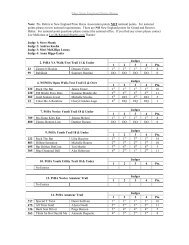2011 Official Rule Book - New England Pinto Horse Association
2011 Official Rule Book - New England Pinto Horse Association
2011 Official Rule Book - New England Pinto Horse Association
Create successful ePaper yourself
Turn your PDF publications into a flip-book with our unique Google optimized e-Paper software.
that roached mane or tail are prohibited. Non-conforming<br />
entries must be eliminated.<br />
3. Entries not to back.<br />
4. To be shown at a walk, trot, slow gait, rack and canter.<br />
5. Entries must walk prior to execution of trot, slow gait,<br />
canter or reverse, but will not walk prior to rack.<br />
B. Gaits<br />
All gaits to be performed in collected balance, with high<br />
action, brilliance, and presence. High head carriage and great<br />
elevation of knees and hocks are normal. Knee flexion should<br />
be proportionate to hock flexion. The animal’s energy should<br />
be directed toward animation rather than speed.<br />
1. Walk: The animated walk is a highly collected gait,<br />
exhibiting much “primp” at a slow, regulated speed,<br />
with good action and animation. It should have snap<br />
and easy control. It can either be a two beat or four<br />
beat gait. It is performed with great style, elegance<br />
and airiness of motion. A flat footed walk is not to be<br />
penalized.<br />
2. Trot: Highly collected, straight, two beat gait.<br />
3. Canter: Slow, lofty and fluid, with definite three beat<br />
cadence, consistent rate of speed.<br />
4. Slow Gait: Restrained four beat gait, executed slowly<br />
but with true and distinct precision; lofty and brilliant;<br />
speed to be penalized. Not a slow rack.<br />
5. Rack: Smooth and highly animated, performed with<br />
great action and speed, in a slightly unrestrained<br />
manner. Should be performed in an effortless manner<br />
from the slow gait.<br />
C. Judging<br />
1. Faults would include: rough, short, or low action, leaning<br />
or lugging on the bit, mixing gaits or tendency to pace;<br />
dragging hocks; unbalanced action; loss of form due to<br />
excessive speed.<br />
2. To be judged on performance, presence, quality, manners,<br />
conformation and suitability.<br />
n10. Two year old English Performance<br />
A. General <strong>Rule</strong>s and Regulations<br />
1. This class may not be held prior to June 1.<br />
2. Refer to specific class requirements (i.e. Hunter Under<br />
Saddle, Hunter Seat Pleasure, Saddle Seat Pleasure, etc)<br />
3. English snaffle bits may be used.<br />
a. The bits may be oval, round, egg-shaped, smooth, or<br />
inlaid.<br />
b. No mouthpiece may be wrapped in metal.<br />
c. Slow twist, corkscrew, double and/or single twisted<br />
wire bits may be used if the bit is a minimum of 5/16”<br />
in diameter a minimum of one inch from the cheek or<br />
ring.<br />
d. Bits may be broken in more than one place<br />
e. No leverage bits (i.e. Pelham, Kimberwicke, shank/<br />
curb bits, etc) may be used.<br />
n11. English Disciplined Rail<br />
A. General<br />
1. This class is to show the ability of a highly trained <strong>Pinto</strong>.<br />
Appointments shall follow those of pleasure classes.<br />
2. Judge shall work the <strong>Pinto</strong>s adequately but must not<br />
overwork the entries. This is not a game or a fault and out<br />
class, and shall not be judged on an elimination basis.<br />
Final judging shall be on the basis of the best overall<br />
disciplined rail performance. At all times, the safety of the<br />
<strong>Pinto</strong>s and exhibitors to be the first concern.<br />
<strong>2011</strong> PtHA <strong>Rule</strong> <strong>Book</strong> 155<br />
ClassEs



